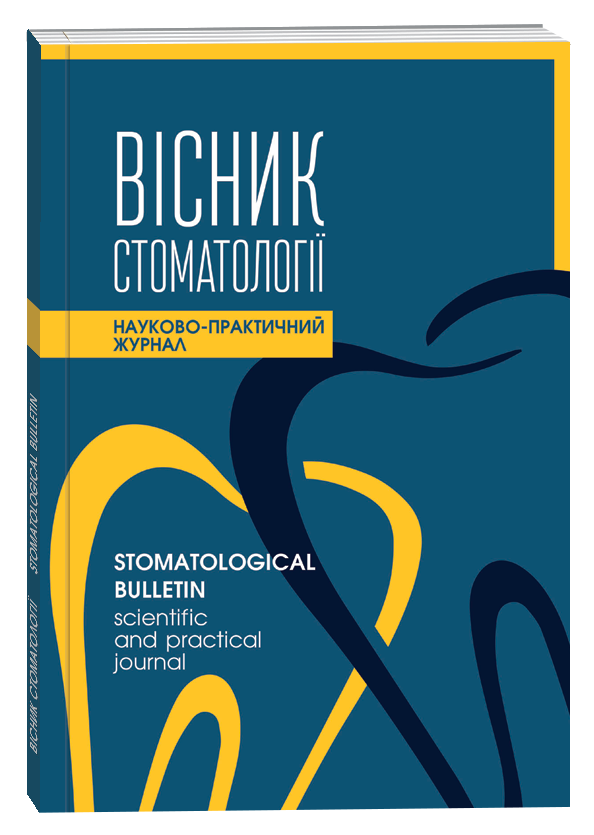ANALYSIS OF INDICATORS OF DENTINE HYPERAESTHESIA IN YOUNG PEOPLE AND THEIR RELATIONSHIP WITH CERVICAL PATHOLOGY OF THE TEETH
DOI:
https://doi.org/10.35220/2078-8916-2022-46-4.5Keywords:
dentine hyperesthesia, wedge-shaped defect, cervical caries, erosionAbstract
Purpose of the study. The study of indicators of dentine hyperesthesia in young people of Donetsk region, evaluation of their potential connection with cervical pathology of the teeth. Research methods. The clinical examination of 272 people (174 women and 98 men) aged 18-44 included a survey, collection of anamnesis data, oral cavity examination. Cervical tooth pathology and dentine hyperesthesia (topography, prevalence, intensity) have been diagnosed. Statistical data processing included the use of the methods of parametric and non-parametric analysis. Scientific novelty. The study revealed a high overall prevalence of dentine hyperesthesia ‑ in 38.2% of the examined that was 1.5 times more common in the patients with cervical lesions of the teeth and 3.5 times more common in women (p>0.05). Its clinical symptoms were observed in 48.4% of the teeth with a wedge-shaped defect, in 42.1% of the teeth with enamel erosion, in 38.0% of the teeth with cervical caries. The localized form of the pathology was diagnosed 2.2 times more often than the generalized form (p>0.05). A moderate correlation was determined between the prevalence of dentine hyperesthesia and the number of the teeth with a wedge-shaped defect (r=0.404) and the combination of cervical lesions (r=0.320), p≤0.05. A reliable relationship was observed between the depth of wedge-shaped defects and the presence of clinical symptoms of hypersensitivity (χ2=8,174, р=0,043). The age of the examinees was inversely correlated with the prevalence of dentine hyperesthesia in patients with erosion (r=-0.36, p=0.02) and it was in direct correlation with its intensity in patients with cervical caries (r=0.60, p=0.0013). A moderate relationship between gender and prevalence (χ2=13,068) and intensity (χ2=13,727) of hypersensitivity symptoms has been determined, p<0.001. Conclusions. The significant prevalence and intensity of dentine hyperesthesia in young people, its potential connection with cervical pathology of the teeth necessitates further research in order to develop effective therapeutic and preventive measures.
References
Мікросклад і мікроструктура зубних паст для лікування підвищеної чутливості твердих тканин зубів / Ю.Г. Коленко, К.О. Мялківський. Сучасна стоматологія. 2019. № 2. С. 36-41.
Десенсибилизация гиперчувствительных зубов – обязательная часть вашего протокола работы с пациентом во время стоматологического приема / Р.В. Симоненко, Н.Н. Васильева-Каташинская. Сучасна стоматологія. 2020. № 3. С. 7-13.
Особенности химического состава твердых тканей зубов у взрослых людей разных возрастных групп при гиперестезии зубов / А.К. Иорданишвили, А.К. Орлов. Институт стоматологии. 2019. № 3. С. 99-101. URL: https://instom.spb.ru/catalog/article/13908/?view=pdf
Nascimento M., Dilbone D., Pereira P., Duarte W.R., Geraldeli S., Delgado A.J. Abfraction lesions: etiology, diagnosis, and treatment options. Clin Cosmet Investig Dent. 2016. Vol. 8. P. 79–87.
Оптимизация методов лечения клиновидных дефектов зубов с симптомом гиперестезии / А.И. Булгакова, Д.М. Исламова, И.В. Валеев, С.В. Давыдова. Стоматология. 2013. № 92(1). С. 46-49. URL: https://www.mediasphera.ru/issues/stomatologiya/2013/1/030039-17352013111
Zuza A., Racic M., Ivkovic N., Krunic J., Stojanovic N., Bozovic D., Bankovic-Lazarevic D., Vujaskovic M. Prevalence of non-carious cervical lesions among the general population of the Republic of Srpska, Bosnia and Herzegovina. Int Dent J. 2019. Vol. 69(4). P. 281-288.
Yoshizaki K.T., Francisconi-Dos-Rios L.F., Sobral M.A., Aranha A.C., Mendes F.M., Scaramucci T. Clinical features and factors associated with non-carious cervical lesions and dentin hypersensitivity. J Oral Rehabil. 2017. Vol. 44(2). P. 112-118.
Teixeira D.N.R., Zeola L.F., Machado A.C., Gomes R.R., Souza P.G., Mendes D.C., Soares P.V. Relationship between noncarious cervical lesions, cervical dentin hypersensitivity, gingival recession, and associated risk factors: а cross-sectional study. J Dent. 2018. Vol. 76. P. 93-97.
Scaramucci T., de Almeida Anfe T.E., da Silva Ferreira S., Frias А.С., Pita Sobral М.А. Investigation of the prevalence, clinical features, and risk factors of dentin hypersensitivity in a selected Brazilian population. Clin Oral Invest. 2014. Vol. 18. P. 651–657.
Liu X.X., Tenenbaum H.C., Wilder R.S., Quock R., Hewlett E.R., Ren Y.F. Pathogenesis, diagnosis and management of dentin hypersensitivity: an evidencebased overview for dental practitioners. BMC Oral Health. 2020. Vol. 20(1). P. 220.
Sadaf D., Ahmad Z. Role of Brushing and Occlusal Forces in Non-Carious Cervical Lesions (NCCL). Int J Biomed Sci. 2014. Vol. 10(4). P. 265–268.
Распространенность некариозных пришеечных поражений и абфракций твердых тканей зубов у взрослых людей в разном возрасте / А.К. Иорданишвили, Д.А. Черный, В.В. Янковский, А.К. Орлов, К.О. Дробкова. Adv Gerontol. 2015; № 28(2). С. 393-398.
Yoshizaki K.T., Francisconi-Dos-Rios L.F., Sobral M.A., Aranha A.C., Mendes F.M., Scaramucci T. Clinical features and factors associated with non-carious cervical lesions and dentin hypersensitivity. J Oral Rehabil. 2017. Vol. 44(2). P. 112-118.
Que K., Guo B., Jia Z., Chen Z., Yang J., Gao P. A cross-sectional study: non-carious cervical lesions, cervical dentine hypersensitivity and related risk factors. J Oral Rehabil. 2013. Vol. 40(1). P. 24-32.
Lussi A., Strub M., Schürch E., Schaffner M., Bürgin W., Jaeggi T. Erosive tooth wear and wedge-shaped defects in 1996 and 2006: cross-sectional surveys of Swiss army recruits. Swiss Dent J. 2015. Vol, 125(1). P. 13-27.









